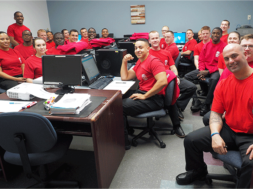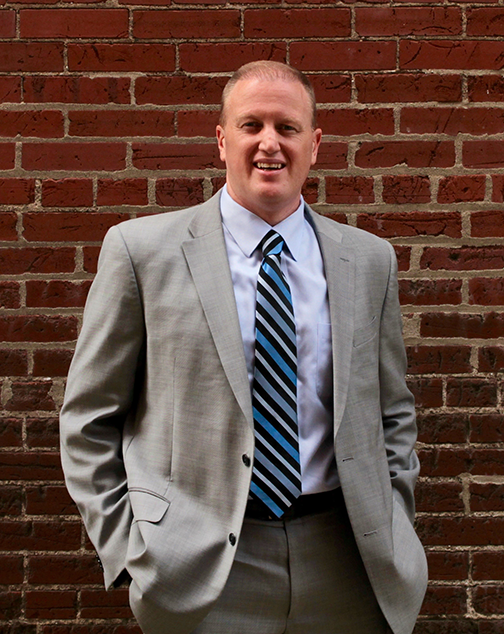
How you can Make 2017 the Year all of Your Goals are Accomplished
By Brian Willett, Owner/Consultant, MPACT Group, Dale Carnegie Training
It’s that time of the year! You know the time. The time when everyone sets their new year’s resolutions and tells themselves, “This is the year I am finally going to lose those 20 pounds, quit smoking, eat healthier, go back to school, budget better, etc.”
These are all good resolutions and goals to have. However, the sad truth is that almost everyone never accomplishes the goals they set.
According to a study conducted by Richard Wiseman from the University of Bristol involving 3,000 people, 88 percent of the goals/resolutions people set, were never accomplished.
We don’t need to look at the research conducted by Mr. Wiseman to determine that most people fail at accomplishing their goals. No, in fact the chances are, you know someone, family, friends, colleagues, who have not accomplished their goals.
I want to challenge you to look in the mirror and ask yourself this question: Am I part of the 12 percent or the 88 percent?
Let’s be honest with ourselves. You are most likely part of the 88 percent. Sorry, but the math tells us this is true. It’s not totally your fault, even though you do play a major role in it. It is a societal issue that has permeated itself for thousands of years.
We as humans are capable of so much, yet, we allow ourselves to get distracted and not accomplish what it is we seek and want to achieve.
Before we get into the formula for success. Let’s first talk about setting goals or new year’s resolutions. How do you do it and what is the best way to do it?
Early on in my role as a leader in admissions I can remember sitting down with my team each year and writing out goals for the year. You know – a goal setting session. Chances are you have done the same thing. Today, I as I look back on these goal setting sessions, I realize that I wasn’t equipped with the right information to be leading these sessions for others, because I wasn’t very good at setting and accomplishing goals myself.
Lesson: If you aren’t very good at establishing goals for yourself, you aren’t going to be very good at helping others create goals for themselves.
The number one mistake that most people make in setting goals is this: Most people don’t set goals.
At least not very defined and specific goals related to what they want to accomplish personally and professionally.
Instead of telling you what goals you need to set in your life and in your school or organization, I want to equip you with a few processes that have helped me become a better goal setter and more importantly, a better goal achiever. And this my friends is what we are seeking to do. We all want to become better at achieving our goals.
As a school leader you most likely set goals in 2016 for your institution, your department, and yourself personally. The questions I have for you:
- Why didn’t you achieve some of those goals?
- What is the goal or what is your plan of action in 2017 to not repeat this?
This weekend as I am writing this article, I asked my wife “What is the definition of goal to you?” She knows me well and was curious to know why I was asking. The two of us had a three-minute conversation on what a goal is. I found one of the things she said very interesting. She said the concept of S.M.A.R.T goals is cliché and overused.
I don’t disagree that a person might feel like the acronym is overused. However, I know for a fact that even if we feel like it is used a lot, not enough people apply it.
Since my humble beginnings as a young admissions leader I conducted goal setting sessions, where the S.M.A.R.T acronym was used. I was explaining a process that I wasn’t using myself. And I didn’t have enough experience with it to articulate its importance to the people I was teaching.
The acronym may be overused in theory, but not overused in practice. Several years later, I can prove it from the hundreds of people I have worked with that knew the concept, but couldn’t put it into practice.
So, what is S.M.A.R.T. I am going to keep it simple, because as I have already stated the more important part is the action.
The acronym S.M.A.R.T has been used and modified for many years. I’ve seen it in so many forms. However, the credit goes to George T. Doran in a November 1981 issue of “Management Review” where Doran introduced this acronym as a process for managers and leaders to set better goals that get accomplished.
S.M.A.R.T is an acronym – a word formed by combining the beginning letters of a name or phrase. An acronym is an easier way for people to remember certain things and expressions, and are much easier to write and teach.
So, S.M.A.R.T is the acronym for these words and expressions:
Specific – What is the desired goal as specific as you can make it.
Measurable – How and what tools will we use to measure success towards the goal.
Assignable – Who is responsible for managing this objective.
Realistic – What is realistic based on available resources.
Time related – When will success be achieved. A date. As well as certain milestones.
Here is an example: Let’s say you want to increase your show rate on your set appointments from 50 percent to 55 percent.
Specific: 5 percent increase.
Measurable: Use reporting out of our CRM weekly to ensure we are doing this.
Assignable: Our admissions coordinator will measure it weekly and provide the data to the Director.
Realistic: This is a realistic goal and we have the resources to accomplish it.
Time related: Our goal is to have the 5 percent increase no later than March 1, 2017 and will need to stay at that rate through the summer start to achieve success.
The S.M.A.R.T formula can be used in the above format from a managerial perspective in assigning projects within your institution. The other acronym used for goal setting from a personal perspective looks like this:
Specific
Measurable
Attainable (Is it an attainable goal that you can achieve.)
Realistic
Time related
The only change is the A from assignable to attainable.
When used properly, this acronym helps people and businesses set goals that are more likely to get accomplished than ones that are not set.
As I stated before, most goals are not accomplished because of these four things:
- Most people don’t set goals, which means they never actually commit to anything.
- They don’t write their goals down.
- They don’t set the right goals with measurable actions to implement. (Applying the S.M.A.R.T formula)
- They don’t have a process that helps them stay on track to accomplish their goals.
The winning doesn’t happen at the setting of the goal. Nope! The winning happens at the finishing of the process to accomplish the goal. Most people don’t finish because they have a flawed plan.
The S.M.A.R.T formula provides the resources to address reasons one through three of why most goals don’t get accomplished.
Here is a simple formula that you can apply to your year, your month, your week, and your day that gives you a process to help you always stay on track to accomplish your goals.
The process I use is called the Stop, Start, and Continue. If you haven’t seen this process before, it isn’t very flashy, but it provides clarity and focus, which is what is missing for most people when it comes to accomplishing their goals.
How do you know if you are on the right track? Is that a question that we should ask ourselves sometimes? I think so. It is a question that we should probably ask ourselves more often.
Throughout the year, you need to constantly ask yourself these three questions as it pertains to accomplishing the goals you have set for your institution as well as yourself.
Doing so will keep you moving towards accomplishing your goals. Simply stated – It keeps you on track.
STOP: There are some things that you should stop doing immediately. If you are 30 pounds’ overweight, you should probably stop your current eating habits and develop some exercise practices. If you don’t have solid exercise and health habits, you should continue to read further and find out what you should start doing.
Do you have negative friends that are bringing you down? Think about it. How are the people you are around influencing your attitude, your decisions, your spending habits? If you aren’t where you want to be, you should STOP spending time with them or limit your time with them.
About four years ago, I made the decision to STOP watching the national news. That one little decision has impacted my life and my success.
What do you need to STOP doing? When will you stop doing it?
As a school owner/leader what is it that you need to STOP doing in 2017 that prevented you from meeting and exceeding the goals of your institution in 2016?
- Did you spend too much time focusing on things that don’t matter?
- Did you spend too much time in your office and not out with the people?
- Were you more reactive than proactive?
There are lots of things that get in the way and keep us from achieving our goals. Most of those things are in our control to eliminate. You can eliminate those activities so you and the institution you lead, can accomplish your goals.
START: I don’t know which one is harder to do: start something or stop something. I guess it just depends on who you are and how motivated you are. There are some things we just must start doing.
Going back to your health. You just must start. Maybe you start with counting calories. Or you start by walking around your neighborhood or street. Whatever it is and how much you do can always change, but you just must START!
You must STOP spending time with your negative friends, but maybe you START by limiting your time with them.
I have a friend that made the decision to START working out, and he made it a priority in his life. It has changed his entire life from health, fitness, family, career, and accomplishing more of his goals.
What should you START doing? When should you START?
As a school leader, you can make decisions throughout your department or the institution. What are some of those things that you could START doing that could have a major impact for your students, your staff, and your faculty?
- What is one thing you need to do every day that could change the culture of your school?
- What is an initiative that can be implemented to help the school achieve its budgets this year?
- What is an initiative that could help students who struggle find the necessary resources to help them succeed?
In our personal lives as well as our professional lives as leaders, owners, or employees we can START taking actions and START doing things that can change the results for ourselves and others, by just starting.
CONTINUE: Then we all have some things that we must CONTINUE to do. There are some things that just work. I hope we all have something(s) in our lives that are working.
We must continue to do those things that work and make sure we find the time to ensure they continue. I found that the best way for me to determine if something works and I should continue to do it, is by doing a lot of things that don’t work. This trial and error process is what has allowed me to find the things I make a priority and continue to do.
In last eight years, a lot of new rules, regulations, processes, etc. have been placed on proprietary institutions that, frankly have caused a lot of frustration and grief.
I am not getting into the politics of this increased scrutiny or the why. Instead, I would ask that you think about what is it you’ve started doing that you need to continue to do because it has made your school better and more successful? Or maybe it was something that you have always done at your institution.
The point with the CONTINUE piece of the process is to give yourself some credit on what you do well.
What are you going to CONTINUE doing? Here are some examples of how you can apply Stop, Start, and Continue to your school:
Leadership
Stop meetings that last too long, by having a specific agenda each week.
Start providing more coaching to staff by spending no less than one hour a week with each individual.
Continue weekly email updates celebrating the success of a person or department.
Student support
Stop allowing students to withdraw from classes without dean approval.
Start an alert system when a student has so many absences.
Continue mentor program partnering new students with current successful students.
Admissions
Stop purchasing leads from X vendor.
Start developing a better internal system so students can refer their friends.
Continue requiring all students to write a letter of intent to attend the school and why they are choosing the school and field of study.
Within this article we pointed out clear processes that you can use to ensure you meet your personal, professional, and institutional goals in 2017. The S.M.A.R.T formula ensures you create specific goals, with a deadline, and a way to measure how you are progressing towards that goal.
The Stop, Start, and Continue questions are there to challenge what it is you are doing or should start doing.
As a leader, I would encourage you to take these three questions and challenge your team to look at the entire institution, the bigger picture of the school itself, and ask what is it that we should Stop, Start, and Continue doing. Start with the 10,000-foot view. Once you clearly define the answers to the questions at this level, you can then start breaking it down further by department, all the way down to asking individuals within your school the same questions.
I use the Stop, Start, and Continue, questions almost daily to determine what it is I need to do and what I should have done. It is a process that as a manager I have applied to coaching people, providing feedback, and consulting.
Most people never accomplish what they want in life or in their career, not because they don’t care. We would all agree that we all care and that we want to have more success for ourselves and more success for our places of employment.
The problem is that we aren’t equipped with the right tools for us to have the success we want. The tools provided in this article can and will change everything when applied consistently with accountability. 2017 will be a lot like 2016, or you can change everything by applying the concepts discussed in this article, and 2017 can be your best year ever personally and professionally.
References:
Richard Wiseman study on New Year’s Resolutions: Wikipedia; https://en.wikipedia.org/wiki/New_Year’s_resolution
S.M.A.R.T acronym; 1981 issue of Management Review
BRIAN WILLETT is a twelve-year veteran of Career College Schools. Brian started his career as an admissions representative and was promoted several times to the position he held up until 2015 as the System Director of Admissions for Kentucky’s largest private university. Brian is the co-owner of MPACT Group Inc., which is an Admissions Training and Secret Shopping company. Brian now works with Dale Carnegie Training providing training and development for businesses and companies around the world.
Contact Information: Brian Willett // Owner/Consultant // MPACT Group, Dale Carnegie Training // 502-296-7632 // bwillett555@gmail.com // brianwillettgroup.com // Social Media: Twitter: @bwillett79 LinkedIn, Facebook, YouTube // brianwillettgroup.com, selfdevelopmentaddict.com











